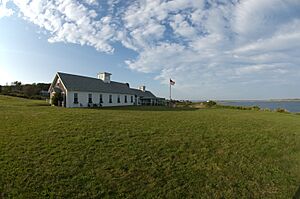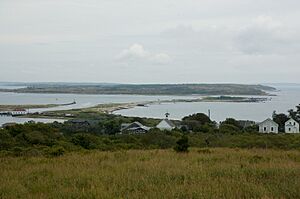Cuttyhunk Island facts for kids
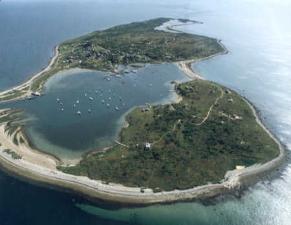
An aerial view of the island
|
|
|
Cuttyhunk (Massachusetts)
|
|
| Geography | |
|---|---|
| Location | between Buzzards Bay and Vineyard Sound |
| Coordinates | 41°25′8″N 70°56′2″W / 41.41889°N 70.93389°W |
| Archipelago | Elizabeth Islands |
| Major islands | Penikese Island and Nashawena Island |
| Area | 2.35 km2 (0.91 sq mi) |
| Length | 1.5 mi (2.4 km) |
| Width | .75 mi (1.21 km) |
| Highest elevation | 154 ft (46.9 m) |
| Highest point | Lookout Hill |
| Administration | |
|
United States
|
|
| State | Massachusetts |
| County | Dukes |
| Town | Gosnold |
| Demographics | |
| Population | 52 |
| Pop. density | 23.32 /km2 (60.4 /sq mi) |
Cuttyhunk Island is the farthest island in the Elizabeth Islands chain in Massachusetts. In 1602, a small English group stayed here for a few weeks. They were collecting sassafras, a tree whose bark was valuable in Europe. This might have been the first English settlement in New England.
Cuttyhunk is located between Buzzards Bay to the north and Vineyard Sound to the south. Nearby islands include Penikese Island and Nashawena Island. The island covers about 580 acres (2.35 square kilometers). In 2000, 52 people lived there. Cuttyhunk is the fourth largest of the Elizabeth Islands and is home to the village of Cuttyhunk. It is part of the town of Gosnold.
Contents
Discover Cuttyhunk Island's Geography
Island Nature and Wildlife
Cuttyhunk Island is about 1.5 miles (2.4 km) long and 0.75 miles (1.2 km) wide. It has a large natural harbor on its eastern side. Half of the island is a special nature preserve. This preserve is home to many birds, like piping plovers and American oystercatchers. You can also find White-tailed deer, white-footed mice, Eastern cottontail rabbits, and a few coyotes.
The island also has many New England wildflowers, bayberry bushes, and sweet peas. Two long land sections, called peninsulas, stretch out from the main island. These are Canapitsit to the south and Copicut Neck to the north.
The shore is mostly rocky, showing that glaciers formed Cuttyhunk. The island is covered with rocks and stones. These types of rocks are usually found only in the mountains of Vermont and New Hampshire.
There are three sandy beaches on Cuttyhunk. One is along the channel leading to the harbor, called Channel Beach. Another is Barges Beach, near sunken barges. The third is "Church's beach." Much of Cuttyhunk's rocky shore has steep cliffs made of rock, sand, and clay.
The western end of the island has West End Pond. This pond is used for shellfish farming. A monument to Bartholomew Gosnold's 1602 landing stands on a small island in this pond.
The highest point on the island is Lookout Hill, which is 154 feet (47 meters) above sea level. On Lookout Hill, you can see old defensive bunkers. The United States Coast Guard built six of these in 1941. They used them to watch for Nazi U-boats during World War II. After the war, the equipment was removed. Now, these bunkers are picnic spots with great views. The Coast Guard station closed in 1964.
Fishing for Striped Bass
Cuttyhunk is famous for its large striped bass. In 1913, Charles Church caught a world-record striped bass weighing 73 pounds (33 kg). This record lasted for many years. Charles Cinto caught another 73-pound striped bass near Cuttyhunk in 1967.
Many fishing guides have called Cuttyhunk home. They use special lures and strong wire to catch large female striped bass. These fish live near the island's rocky reefs from spring to autumn. Sow and Pigs Reef is a well-known spot where Mr. Cinto caught his record fish.
Cuttyhunk Island's Past
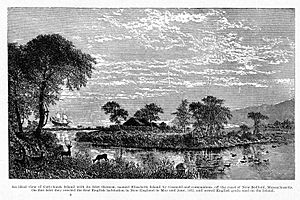
| The Elizabeth Islands |
|---|
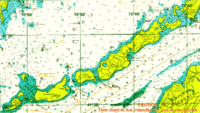 |
| Major Islands listed in order from east to west |
| Nonamesset Uncatena Naushon Pasque Nashawena Penikese Cuttyhunk |
| Minor Islands: |
| Bachelor Baret Bull Cedar Gosnold Gull Rock Veckatimest Weepecket Islands |
The Wampanoag tribe, who were the native people, first called the island Poocuohhunkkunnah. This name likely meant "Point of departure" or "Land's end." In 1602, the English explorer Bartholomew Gosnold renamed it.
On March 6, 1602, Gosnold sailed from England on a ship called The Concord. He wanted to start a colony in America. Gosnold and his crew landed near Kennebunkport, Maine. Then they explored Cape Cod, Martha's Vineyard, and Cuttyhunk. They built a small fort on Cuttyhunk to collect sassafras, which was very valuable in Europe. After exploring for less than a month, they returned to England.
Over the years, the island changed owners several times. In 1606, the King gave the Elizabeth Islands to the Council of New England. Later, they became the property of William Alexander, 1st Earl of Stirling. He sold them to Thomas Mayhew in 1641. In 1663, James Stuart, Duke of York took control.
In 1668, Mayhew sold Cuttyhunk to Philip Smith, Peleg Sanford, and Thomas Ward. In 1688, Peleg Sanford bought out his partners. He then sold half the island to Ralph Earle of Dartmouth. Ralph Earle Jr., his son, became the first permanent English settler on the island. Early colonists cut down all the trees, leaving the island bare.
In 1693, Peleg Slocum bought all the land on Cuttyhunk. The Slocum family owned the island for the next 165 years.
In 1858, William C.N. Swift, Thomas Nye, and Eben Perry bought Cuttyhunk from Otis Slocum for fifty dollars. In 1864, the town of Gosnold was officially formed.
Important Dates in Cuttyhunk's History
- 1872–73: The Cuttyhunk school was built.
- 1874: The first town meeting was held.
- 1889: The town cemetery was started.
- 1892: The town library was created.
- 1976: A large wind turbine was built. It helped provide electricity to the island.
The Cuttyhunk Fishing Club
In 1864, some fishermen from another club wanted to start their own. They visited Cuttyhunk and decided it was the perfect spot. In 1865, these wealthy men from New York bought a large part of the island. They built 26 "fishing stands." These were long wooden platforms that reached out into the ocean from the rocks.
The club first allowed only 50 members. If even one member voted no, a person could not join. The joining fee was $300. Later, the club expanded to 60, then 75 members.
Every evening, members drew lots to decide which fishing stand they would use the next day. Each member had a "chummer," a young boy who would bait their hook with lobster tail. The chummer also threw pieces of lobster into the water to attract striped bass. Chumming helped attract fish. The chummer was paid $1 per fish caught, or more for very large fish. Records were kept of all the fish caught. Cuttyhunk became known as a top spot for sportfishing, especially for striped bass.
The Cuttyhunk Fishing Club gave land to the Cuttyhunk Church in 1880. The church celebrated its 125th anniversary in 2006. Every Fourth of July, the club hosted a party for island residents, including fireworks.
In 1921, William M. Wood bought the Cuttyhunk Fishing Club's land and other available property. He wanted a summer place for his young children. He invited other wealthy friends to buy summer homes on the island. This way, his children would have playmates. The Wood family still owns much of the island today. Many families who bought property from Wood still spend their summers on Cuttyhunk.
Lighthouses, Pilots, and Shipwrecks
The waters around Vineyard Sound and Buzzards Bay were very dangerous for new sailors. Early in the island's history, many island men became "pilots." They guided boats safely past dangerous reefs to ports like New Bedford, Providence, and Boston.
Men would stand on Lookout Hill with spyglasses. They watched for whaling ships heading to New Bedford. When a ship appeared, they would race to their boats. The first one to reach the ship would offer to guide it. In 1903, Cuttyhunk pilots guided up to eleven ships a day to New Bedford harbor.
The reefs were indeed dangerous. In 1847, the Massachusetts Humane Society set up life-saving stations on the Elizabeth Islands. These stations had supplies to help islanders assist boats in trouble.
The old lighthouse was taken down in 1947 and replaced by a metal tower. The lighthouse keeper's house was also destroyed. The new tower no longer works. The only part left from the old lighthouse station is a stone oil house, but its door and roof are gone.
Famous Shipwrecks
- February 24, 1893: The ship Aquatic crashed off Sow and Pigs reef. Five Cuttyhunk lifesavers died trying to save the people on board.
- November 27, 1898: The steamer Fairfax crashed off Sow and Pigs reef during a huge storm called the Portland Gale. This storm sank over 150 ships and caused 400 deaths. Even with the terrible storm, all six passengers and the crew of the Fairfax made it to safety.
- August 26, 1924: The whaling ship Wanderer was the last such ship to leave New Bedford. It anchored near Cuttyhunk on August 25, 1924, waiting for its crew to be complete. The next morning, the seas got rough. The Wanderer dragged its anchors and drifted towards Sow and Pigs reef. When the anchor chains broke, the crew knew the ship was lost. They left the ship in two smaller whaleboats. Cuttyhunk lifesavers went to help, but the two boats had disappeared. One boat reached Cuttyhunk, and the other reached a lightship in Vineyard Sound.
Years later, a grinding stone from the Wanderer was found. It was holding up the old stairs to the Cuttyhunk Corner Store. This store is one of two gift shops on the island. The stone, with "Wanderer" clearly carved into it, is now set into the new floor of the gift shop.
- August 1992: The large ocean liner Queen Elizabeth 2 hit an unknown sandbar about 2.5 miles (4 km) south of Cuttyhunk. The ship was badly damaged, costing $13.2 million to fix. The company lost $50 million because the ship could not be used for a while.
Life and Culture on Cuttyhunk
Cuttyhunk is part of the town of Gosnold, Massachusetts. About 10 people live on the island all year. In the summer, the population grows to about 400 with vacationers and boaters. Cuttyhunk has a few trucks, but most people walk or use golf carts to get around. The island's natural harbor is a popular place for boaters to stay.
Cuttyhunk is still a favorite spot for sportfishing. Striped bass and bluefish are the most common catches. Some island residents work as lobstermen, boat builders, shellfish farmers, and carpenters. A ferry called the M/V Cuttyhunk travels frequently from New Bedford to Cuttyhunk during the summer.
The island has one bed and breakfast, the Cuttyhunk Fishing Club. There are also many homes for rent for summer tourists. Because the island is small, other services are limited. There are three retail stores and a few places to eat lunch or dinner.
The island's only school had one teacher and three students in August 2009. In June 2019, eighth grader Gwen Lynch was the only graduate. The school plans to reopen as a STEAM Academy. This academy will offer weeklong programs instead of having full-time students.
Notable People from Cuttyhunk
- Paul Cuffe (1759–1817)





